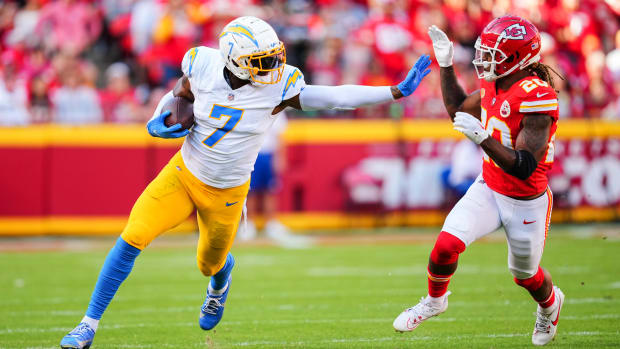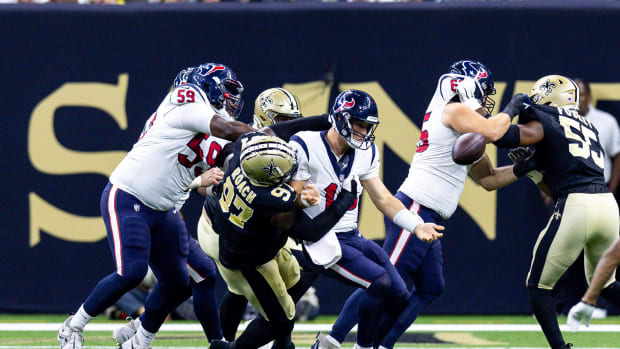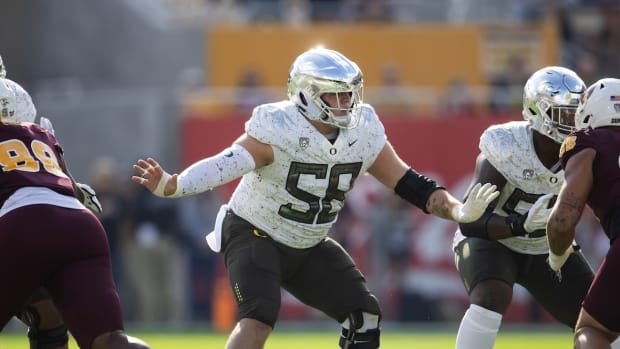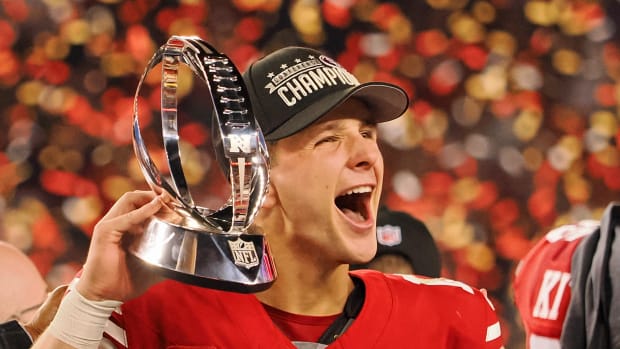Raiders Preview: Putting the Pieces in Place
D.J. Hayden and the rest of the secondary is charged with executing a complex scheme. (John W. McDonough/Sports Illustrated)
Throughout the preseason Andy Benoit will provide in-depth breakdowns of all 32 teams, in reverse order of 2013 finish. Today, the Oakland Raiders …
DEFENSE
Trying to follow a Raiders’ defensive game-plan can be like trying to follow the plot of a David Foster Wallace novel. The content is vast, unusual, creative and often scattershot.
A problem for Oakland is that head coach Dennis Allen and defensive coordinator Jason Tarver, who handles the nuts and bolts of the defense, have not had the right personnel to run their voluminous scheme. Tarver has one of the sharpest, fastest minds the NFL has seen. The 39-year-old’s greatest challenge as a coach will always be connecting with players and colleagues who simply aren’t as smart as him.
If you play anywhere in Oakland’s defensive back seven—whether it’s linebacker, safety or cornerback—Tarver expects you to know a litany of blitz angles, coverage concepts, shifts and rotations, as well as pre-snap disguises. Even more daunting is that many of these ploys are based on keying and diagnosing, meaning you blitz, cover or rotate depending on how the offense lines up.
Defensive linemen also have a bundle to take in. Allen, Tarver’s superior, prefers to use multifaceted hybrid fronts. The Raiders front line was weak, literally, last season. Most of its starters were assuming full-time roles for the first time in their veteran careers, and they wore down as the season progressed.
Aside from underrated tackle Pat Sims, it’s an all-new defensive front in 2014. It’s also a short-term one, as all three new starters will be on the wrong side of 30 by season’s end. The highest profile acquisitions are defensive ends LaMarr Woodley and Justin Tuck, though the best of the bunch is Antonio Smith, a high-octane gap-shooter with a rich arsenal of moves.
A rich arsenal of moves is actually what propelled Tuck’s career in New York, though that success tapered off the past few years (he rebounded a bit last season but wasn’t as effective as his 11 sacks suggest). Woodley has also been tapering off. A 3-4 outside linebacker his entire career so far, the 265-pounder will now play with a hand in the dirt. It isn’t a big adjustment on pass rushes but could present challenges setting the edge in run support.
There was room to bring on Woodley and Tuck, as well as ex-Packers backup C.J. Wilson (who should be able to play inside or outside) because end Lamarr Houston left in free agency. At 27, Houston was more dynamic than these veterans, but he wasn’t worth breaking the bank for because he lacks elite edge-rushing speed. The Raiders didn’t find elite speed in the cheaper Woodley or Tuck, but they did in the draft, taking Khalil Mack, who unexpectedly fell to No. 5.
2014 Team Previews
Andy Benoit dives deep with breakdowns of all 32 teams during the preseason.
PREVIEWS
Tuck will slide inside on passing down to make room for Mack. In addition to edge speed, a big part of Mack’s appeal was his potential as a five-tool hybrid defender at the second level. Tarver can make great use of such diverse athleticism—especially when it’s paired with that of a similar (though less dynamic) young outside backer in Sio Moore. The 2013 third-round pick has shown upside in coverage and decent pass-rushing acumen, particularly as a blitzer.
Ideally, Mack and Moore will capture starting jobs, wedging out veteran Kaluka Maiava, as well as the fast but less alert Miles Burris. With Mack playing off the edge, there’s still room for starting middle linebacker Nick Roach in the nickel package. Roach is a very up-and-down player in all facets of execution and field-reading.
It’s in nickel (and dime) where Tarver asks the most of his men, particularly the secondary. The return of strong safety Tyvon Branch (broken leg last year) really helps, if for no other reason than it gets his replacement, the totally ill-equipped Brandian Ross, back on the bench. Branch’s discomfort in deep space makes him far from elite in coverage, but he’s just capable enough to be interchangeable with Charles Woodson.
Tarver did not ask the 37-year-old Woodson to play near the line of scrimmage much in 2013, though that’s because Woodson was the team’s only capable centerfielding safety. While Branch is best as a thumper in the box, Woodson does his damage by slithering around blockers and sniffing out play designs. Like a great point guard, he uses his understanding of spacing and angles to create opportunities for others (in this case it’s tackling opportunities, not scoring; Woodson likes to do his own scoring, having registered an NFL record-tying 13th career defensive touchdown last season).
Joining the safeties is a revamped cornerbacking group that features two veterans brought across the bay in free agency: Carlos Rogers and Tarell Brown. Neither is a difference-maker (the Niners let them go for a reason), but both are significant upgrades over what was here last year. At this point the 29-year-old Brown is the more potent of the two, though the 33-year-old Rogers may be more important. His ability to play the slot means D.J. Hayden can stay outside fulltime. Assuming injuries don’t take a toll on the 2013 first-round pick (he missed his rookie offseason following abdominal surgery and landed on I.R. last November with a groin injury, and this offseason he missed time with a bum ankle), Hayden is expected to emerge as this team’s top corner. He has natural fluidity getting in and out of his backpedal, it’s just a matter of learning to apply it at the pro level. The former JUCO transfer and University of Houston star had several wide-eyed moments as a rookie, both in terms of reading the field and reacting to NFL-quality route runners.
The Raiders will lighten the load of the injury-prone McFadden. (Ezra Shaw/Getty Images)
OFFENSE
The last thing Allen and his staff want is to endure the growing pains of a rookie quarterback. They’re already on owner Mark Davis’s hot seat, and the belief is that, with year three having all along been the “realistic” target for visible progress in a massive rebuilding effort, another bad record could spell the end for this regime (that includes general manager Reggie McKenzie).
Of course, it’s not realistic to think Oakland’s offense is suddenly set to turn things around—especially given that the team’s much-anticipated free agent spree came in the same year that a raised salary cap made more than half of the league competitors on the open market. But realism has not been an obstacle for any Davis in recent years.
The fear over relying solely on a rookie was why Allen and McKenzie sought Matt Schaub in a trade from Houston. You don’t have to be an expert to see that Schaub is not a top-tier quarterback. His already limited arm strength appeared to lose even more zip last season and his decision-making never seemed to account for that. With a quarterback who can’t make all the throws, it’ll be impossible for offensive coordinator Greg Olson to do everything he wants schematically.
But at least Olson now has a quarterback who knows how and where to throw. He didn’t have that last year. To accommodate Schaub, Olson will have to incorporate more moving pocket concepts, giving his passer a larger platform to launch from. (The smaller the platform, the more arm strength required.) That’s a whole lot better than the one-read and run-oriented concepts that Terrelle Pryor was restricted to.
Moving platforms are also a good way to accommodate Derek Carr, should the second-round rookie, whom McKenzie presumably drafted for the future, be able to capture the starting job. Carr did not show great comfort throwing with bodies around him at Fresno State (the same issue his brother had); moving platforms are a way to hide that. They can also be a way to simplify a quarterback’s reads.
Quarterback is not this offense’s only revamped position. After finding nine new defensive starters a year ago, McKenzie this year found at least six new offensive starters. The most recognizable is Maurice Jones-Drew, who is hoping to prove he still has the lateral agility and burst that made him a three-time Pro Bowler in Jacksonville. Lateral agility is something Darren McFadden has never had, which is one reason why the fragile seventh-year pro has become little more than a rotational back. McFadden does, however, have the north/south explosiveness to be a playmaker if given the ball in space.
Jones-Drew and McFadden are both viable receivers out of the backfield, as is fullback Marcel Reece. A wide receiver in college, Reece is a mediocre lead-blocker (at best) but gets regular playing time because he gives this offense a critical dimension as a flex piece. That’s something most teams get from their tight ends, but barring a quantum leap from improving 2013 sixth-rounder Mychal Rivera or H-back David Ausberry, the Raiders don’t have an every-down receiving weapon at this position.
With his job potentially on the line, Allen will have to choose between underwhelming veteran Schaub (right) or unproven rookie Carr (left). (Ben Margot/AP)
With minimal blocking fortitude at fullback and tight end, Olson might be inclined to use the six-man offensive lines that he regularly employed last season. With three capable tackles, he has the resources. Top-heavy newcomer Donald Penn will go through highs and lows on the left side, but he’s a sizeable upgrade over Khalif Barnes. Barnes will slide back to his more-fitting guard position, where he’ll try to fend off third-round rookie Gabe Jackson. On the right side, Austin Howard is a classic mauler who will need help in pass protection.
That’s where Menelik Watson could come in. The 2013 second-round pick has a long ways to go with his technique, but the athleticism is there. He’s a very good on-the-move run-blocker, which could prove valuable in some of the six-man fronts. Filling out the line is center Stefen Wisniewski, who should be better now that he’s playing alongside ex-Giant Kevin Boothe rather than pass-blocking sieve Lucas Nix.
Olson can have more trust in his pass protection this season, leading to an expanded aerial attack. The addition of James Jones means the Raiders finally have a wideout with a chance at separating from man coverage on his own. The ex-Packer is not a star, but he’s effective on quick slants and can occasionally get over the top.
Starting opposite Jones will be Rod Streater, though don’t be surprised if Andre Holmes captures this job before season’s end. Holmes, a 26-year-old journeyman, has acrobatic deep ball abilities. Waiver pickup Greg Little is also more physically gifted than Streater, though his reliability is dubious considering the Browns, who are desperate for receivers, cut him months before training camp. Somewhere in the rotation will also be Denarius Moore, another deep threat. Though unlike Holmes, he can’t make plays without getting separation. This unrefined receiving corps has field-stretching abilities, which could be enough to convince Allen (or Mark Davis) to sit the weak-armed Schaub and roll dice with the rookie Carr.
SPECIAL TEAMS
Sebastian Janikowski still has power, though his 70% success rate was the worst among all kickers last season. Punter Marquette King had a very solid 40.1 net average, and it would have been higher if not for 11 touchbacks, tied for second most in the league. Return game duties will be decided in camp; one option, at least on kickoffs, could be special teams maven Taiwan Jones.
BOTTOM LINE
New players, same tough season ahead in Oakland. This club should be better than 4-12, but it won’t be better than 8-8.









































